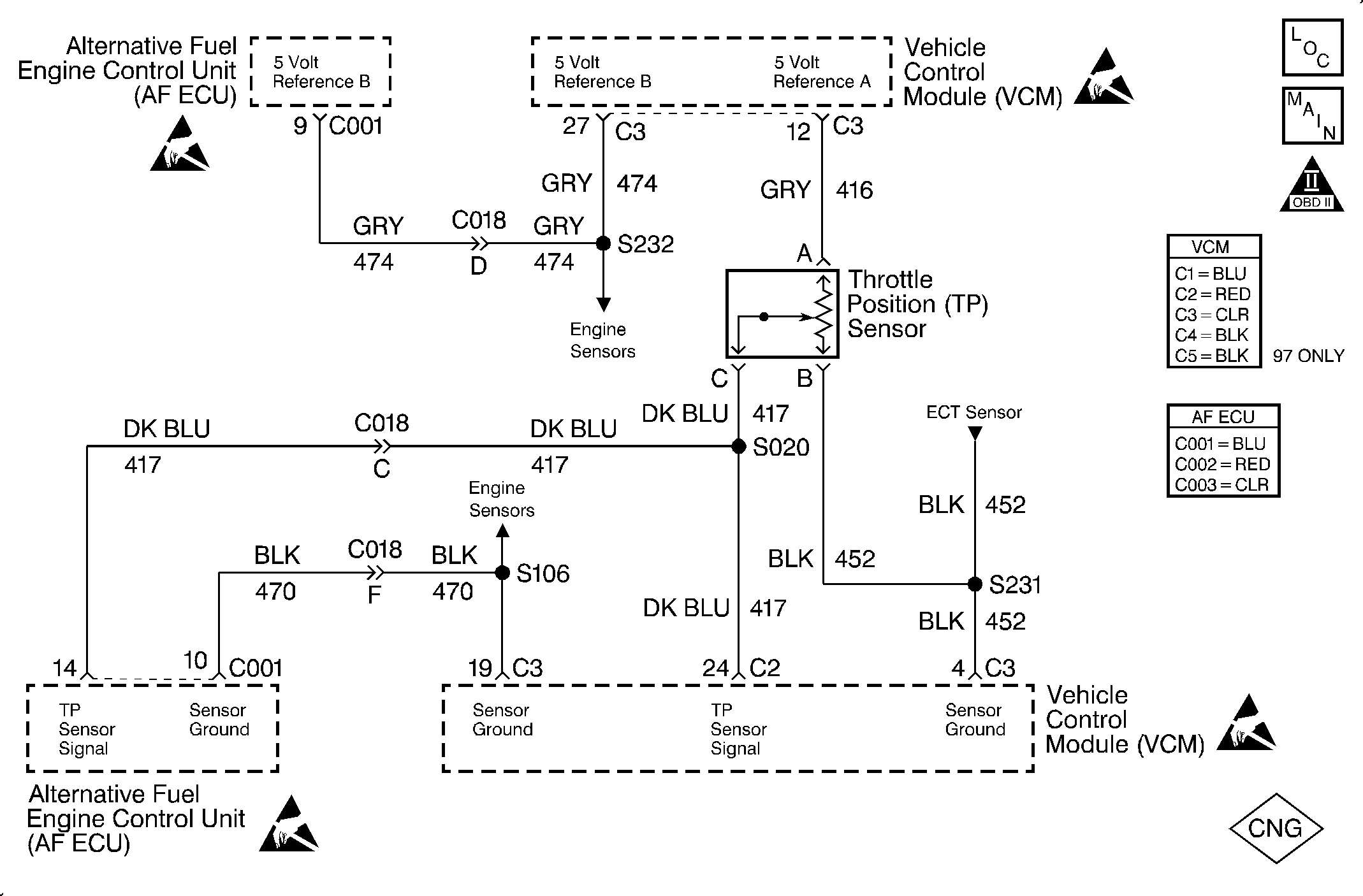
Circuit Description
The Throttle Position (TP) sensor provides a voltage signal that changes relative to the throttle opening. The TP sensor signal voltage varies from about 0.6 volt at idle to about 4.8 volts at Wide Open Throttle (WOT).
The TP sensor signal is an important input used by the ECU for fuel trim and diagnostic functions.
This is a type B DTC.
Conditions for Setting the DTC
The following conditions will set the DTC:
| • | The vehicle is in the CNG operation mode. |
| • | The engine is running. |
| • | The manifold pressure is less than 55 kPa. |
| • | None of the following DTCs are active: 14, 15, 16, 21, 22, 23, 25, 32, 36, 37, 41, 42, 43, 44, 45, 51, 52, 53, 54, 55, 56, 58, 62, 63, 64, 65. |
| • | The TP angle is out of range in relation to the engine RPM. |
By monitoring MAP and RPM, the ECU determines if the TP angle is within a predetermined operational window. DTC 26 will be set if the TP sensor falls outside this window.
Action Taken When the DTC Sets
The ECU sets the DTC 26 after 2 consecutive driving trips with the fault active.
Conditions for Clearing the MIL/DTC
The ECU turns the MIL OFF after 3 consecutive driving trips without a fault condition present. A DTC will clear if no fault conditions have been detected for 40 warm-up cycles (coolant temperature has risen 40°C (72°F) from the start-up coolant temperature and the engine coolant temperature exceeds 70°C (160°F) during that same ignition cycle) or the code clearing procedure has been used.
Diagnostic Aids
Always diagnose ANY VCM codes that are present before beginning this diagnostic procedure.
A scan tool displays the throttle position in volts. It should display 0.40 volt to 0.90 volt with the throttle closed and the ignition ON or at idle. The voltage should increase at a steady rate as the throttle is moved toward Wide Open Throttle (WOT). Also, the scan tool displays the throttle angle percentage where 0% = closed and 100% = WOT.
Check the condition of the connector and sensor terminals for moisture or corrosion. Clean or replace the seal as needed. If corrosion is found, check the condition of the connector seal and repair or replace as necessary. If the DTC is intermittent, refer to Intermittent Conditions .
Test Description
The number(s) below refer to the step number(s) on the diagnostic table.
-
The TP sensor has an auto-zeroing feature. If the voltage reading is within the range of about 0.4 to 0.9 volt, the ECU/VCM uses that value as a closed throttle. If the reading is out of the auto-zero range at closed throttle, check for a binding throttle or a damaged linkage. If the throttle and the linkage are OK, continue with the diagnosis.
-
The TP sensor voltage should go low if the ECU/VCM and the wiring are OK with the TP sensor disconnected.
Step | Action | Value(s) | Yes | No |
|---|---|---|---|---|
1 | Was the Alternative Fuels (AF) Powertrain On-Board Diagnostic (OBD) System Check performed? | -- | Go to Step 2 | Go to Alternative Fuels (AF) Powertrain On Board (OBD) System Check |
Does the scan tool display the TP sensor percentage above the specified value? | 2% | Go to Step 4 | Go to Step 3 | |
3 |
Does the scan tool display the TP sensor percentage above the specified value? | 0%-99.6% 2% | Go to Step 4 | Go to Step 5 |
Disconnect the TP sensor electrical connector. Does the scan tool display the TP sensor at the specified value? | 0.00 V | Go to Step 7 | Go to Step 10 | |
5 |
Is there continuity? | -- | Go to Step 6 | Go to Step 8 |
6 | The DTC is intermittent. If no additional DTCs are set, refer to the Diagnostic Aids. If additional DTCs are set, refer to those tables. Are any additional DTCs set? | -- | Go to the applicable DTC table | -- |
7 | Check for faulty connections at the TP sensor. Was a problem found? | -- | Go to Step 8 | Go to Step 9 |
8 | Repair the circuit as necessary. Refer to Repair Procedures in Electrical Diagnosis in the C/K Truck Service Manual. Is the action complete? | -- | Go to Step 13 | -- |
9 | Replace the TP sensor. Refer to TP Sensor Replacement in Engine Controls - 5.0, 5.7L in the C/K Truck Service Manual. Is the action complete? | -- | Go to Step 13 | -- |
10 | Disconnect ECU connector C001. Does the scan tool display the TP sensor at the specified value? | 0.00 V | Go to Step 11 | Go to Step 12 |
11 | Replace the ECU. Refer to Engine Control Unit Replacement . Is the action complete? | -- | Go to Step 13 | -- |
12 | Replace the VCM. Important:: Reprogram the VCM if it is faulty. Refer to VCM Replacement/Programming in Engine Controls - 5.0, 5.7L in the C/K Truck Service Manual. Is the action complete? | -- | Go to Step 13 | -- |
13 |
Does the diagnostic run and pass? | -- | Go to Step 14 | Go to Step 2 |
14 | Are any DTCs displayed that have not been diagnosed? | -- | Go to the applicable DTC table | System OK |
